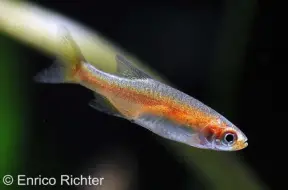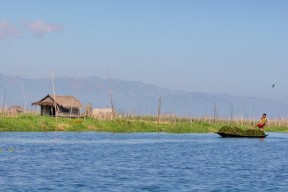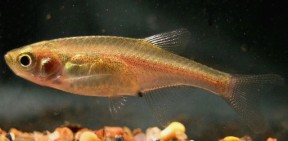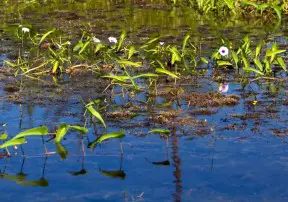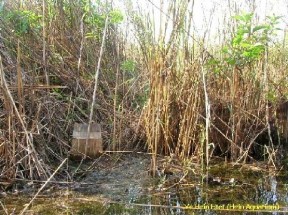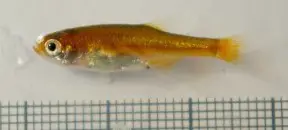Microrasbora rubescens
Red Dwarf 'Rasbora'
Etymology
Microrasbora: from the Ancient Greek μικρός (mikrós), meaning ‘small’, and the generic name Rasbora, in allusion to the small size of this genus and its superficial similarity to the Rasbora grouping.
rubescens: from the Latin rubescens, meaning ‘reddish’, in allusion to the orange-scarlet flanks, ventral surface of head, caudal, anal and sometimes dorsal fins.
Classification
Order: Cypriniformes Family: Cyprinidae
Distribution
Endemic to the isolated mountain lake of Inlé and surrounding watershed in Shan State, eastern Myanmar.
Type locality is ‘Shan States, Lake Inle and Heca plains, Myanmar’.
The species is currently listed as ‘Endangered’ on the IUCN Red List due to a significant decline in the wild population. Unsustainable agricultural practices in and around the lake have caused increases in sedimentation, eutrophication, and pollution along with a reduction in surface area of more than 30% between the years 1935-2000. Non-native, predatory Parambassis and Tilapia species have been introduced for farming, while collection for the aquarium trade may also be exerting a negative effect.
Habitat
Lake Inlé lies in a karstic valley almost 900m above sea level in the Shan Plateau region and is home to many endemic animals including nine species of fish and numerous gastropods. The water is clear, shallow (2-3 metres deep in most places) and has a very fertile, loamy substrate, although it can be muddy and turbid around the margins.
It is famed for its stilted villages and local fishermen known as Intha who row their boats using only one leg. These people, thought to have migrated from the south of Myanmar in the late 1300s, use naturally-occurring floating ‘islands’ consisting of tangles of various plant species as gardens.
These islands form a wide raft around the lake margins, rising and falling with the water level, and have come to form the habitats of many fishes which take shelter among the tangle of roots and plant stems at their base. Macrophytes also grow densely in places.
Maximum Standard Length
25 – 30 mm.
Aquarium SizeTop ↑
Base dimensions of 60 ∗ 30 cm or equivalent are recommended.
Maintenance
Best maintained in a densely-planted tank and is an excellent choice for the carefully-aquascaped set-up.
Filtration should be relatively gentle, while the addition of some floating plants and driftwood roots or branches to diffuse the light entering the tank also seems to be appreciated.
Water Conditions
Temperature: 20 – 24 °C
pH: 6.0 – 8.0
Hardness: 54 – 268 ppm
Diet
Likely to feed on small invertebrates and other zooplankton in nature.
Newly-imported specimens are often in poor condition and can be difficult to acclimatise to aquarium life. Small live foods are therefore recommended as an initial diet with dry and frozen products being introduced as the fish become settled.
Behaviour and CompatibilityTop ↑
Likely to be intimidated or outcompeted for food by larger or more boisterous tankmates, although the presence of similarly-sized, surface-dwelling species seems to help reduce its shyness.
The closely-related Microrasbora cf. rubescens is not recommended as these two may be capable of hybridisation.
It is a shoaling species by nature and a group of at least 8-10 specimens should be purchased. Maintaining it in such numbers will not only make the fish less nervous but result in a more effective, natural-looking display. Males will also display their best colours and some interesting behaviour as they compete with one other for female attention.
Sexual Dimorphism
Mature females are usually deeper-bodied and noticeably larger than the more compact, intensely-coloured males.
Reproduction
Like many small cyprinids this species scatters eggs randomly, typically among aquatic vegetation, and does not exhibit parental care. If the fish are in good condition they will spawn often and in a mature planted aquarium it is possible that small numbers of fry may start to appear without intervention.
However if you want to increase the yield a slightly more controlled approach is required. The adult group can still be conditioned together but one or more smaller containers should also be set up and filled with aged water. Fill much of the available space with fine wool mops, Taxiphyllum or other fine-leaved plant. Neither lighting nor filtration is necessary although a small air-powered sponge filter can be installed if you prefer.
When the adults are suitably-conditioned a single pair or group comprising several males and females is then introduced to each container; the more individuals involved the greater probability of egg predation. Males may also distract one another from females if several are present
Spawning normally presents few problems with around 30 mildly adhesive eggs deposited in a typical event. The adults are best removed post-spawning as they will eat any eggs or fry they find. Incubation is temperature-dependent to an extent but normally around 72-96 hours with the young free-swimming 1-2 days later. Initial food should be 5-50 micron grade, introducing Artemia nauplii, microworm, etc., once the fry are large enough to accept them.
NotesTop ↑
This species may be seen on sale under various trade names including ‘red-line dwarf rasbora’, ’emerald dwarf rasbora’, or ‘red dwarf rasbora’.
A similar-looking, apparently undescribed congener has been collected near the town of Hopong, also in Shan State. It differs from M. rubescens by possessing a greenish to bluish lateral stripe plus a larger adult size, and is traded as Microrasbora cf. rubescens, M. ‘thuzari’, M. sp. ‘rose blue line’, ‘Asian Cardinal Rasbora’, or ‘flame red rasbora’.
The genus Microrasbora has undergone a number of systematic changes in recent years but currently contains only M. rubescens. A phylogenetic study by Fang et al. published in 2009 revealed that other species formerly included in the grouping are more closely allied with Devario and reclassified them as members of new genus Microdevario, further separated from Microrasbora by differences in some aspects of internal morphology.
M. rubescens was also found to be closely related to Devario and the authors conclude that ‘its status as a valid genus is contentious and the molecular data suggest inclusion or close relationship with Devario‘. The two were not synonymised because, unlike those species moved into Microdevario, M. rubescens does not share any derived morphological characters with Devario and in the tests performed the precise level of relatedness between the two could not be settled upon.
References
- Annandale, N., 1918 - Records of the Indian Museum (Calcutta) 14: 33-64
Fish and fisheries of the Inlé Lake. - Fang, F., M. Norén, T. Y. Liao, M. Källersjö and S. O. Kullander, 2009 - Zoologica Scripta 38(1): 1-20
Molecular phylogenetic interrelationships of the south Asian cyprinid genera Danio, Devario and Microrasbora (Teleostei, Cyprinidae, Danioninae). - Kottelat, M., 2013 - Raffles Bulletin of Zoology Supplement 27: 1-663
The fishes of the inland waters of southeast Asia: a catalogue and core bibiography of the fishes known to occur in freshwaters, mangroves and estuaries. - Liao, T. Y., Kullander, S. O. and F. Fang, 2009 - Zoologica Scripta 39(2): 155-176
Phylogenetic analysis of the genus Rasbora (Teleostei: Cyprinidae).
